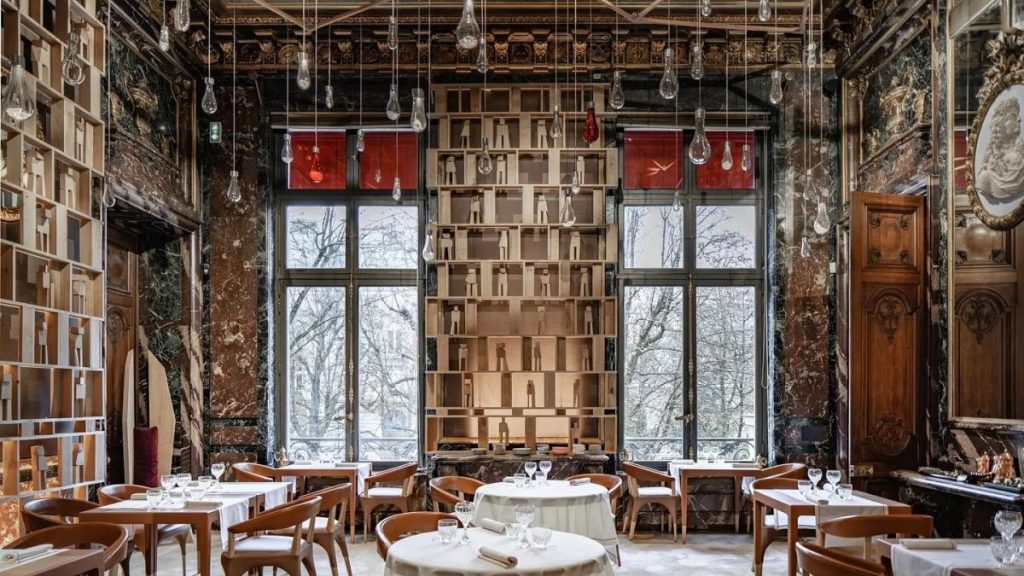The Prix Versailles, a renowned global architecture award, recently unveiled its annual list of the world’s most exquisite restaurants. This year’s selection emphasizes not just culinary delights but also stunning aesthetics. The top honors went to dining establishments that blend artistic design with innovative cuisine, making them a sensory feast for patrons and critics alike.
| Article Subheadings |
|---|
| 1) Top Winner: Gerbou in Dubai |
| 2) The Sophistication of Smoked Room |
| 3) European Contender: Lobster Club |
| 4) Finnish Charm: Bouchon Carême |
| 5) Parisian Classics: Ladurée Rue Royale and Ducasse Baccarat |
Top Winner: Gerbou in Dubai
Claiming the top spot in this year’s Prix Versailles awards is Gerbou, a uniquely designed restaurant situated in the heart of Dubai. Known for its seamless blend of traditional Emirati craftsmanship with modern aesthetics, Gerbou has captured the attention of both locals and international visitors alike. The restaurant is adorned with camel leather sofas, intricately designed ghaf wood chairs, and an innovative lighting setup that mimics fish scales, creating a warm yet contemporary atmosphere.
Culinary excellence is at the forefront of Gerbou, led by Chef Ionel Catau who has crafted a menu that draws predominantly from locally sourced ingredients—about 70%—to revitalize traditional recipes with a contemporary twist. This emphasis on local sourcing is not only a testament to sustainability but also enhances the overall dining experience, allowing patrons to enjoy dishes that reflect the rich cultural heritage of the region. The restaurant is swiftly becoming a sensory hub, where design meets flavor.
The Sophistication of Smoked Room
In the second position is the Smoked Room, another Emirati culinary gem situated in Dubai. This Michelin-starred restaurant offers an intimate dining experience, seating only 14 guests at a time. The decor is characterized by black brick walls juxtaposed with mirrors and brass mesh, creating a sophisticated and moody ambiance.
Here, diners can indulge in an Omakase menu, a traditional Japanese approach that showcases a chef’s selection of seasonal ingredients. The artistic presentation of each dish combines flavors and textures that resonate beautifully with the restaurant’s overall design aesthetics. This exclusivity, paired with exceptional cuisine, has made Smoked Room an exhilarating destination for food connoisseurs.
European Contender: Lobster Club
The award for the top European entry went to Lobster Club in Majorca, Spain. This contemporary sea club encapsulates the Mediterranean lifestyle through its layout and design, created by renowned designer Sandra Tarruella in collaboration with Juan Picornell of Grupo Cappuccino. The restaurant features fluid dining zones centered around a striking bar, allowing for a social and relaxing atmosphere.
With its panoramic terrace that reduces the barriers between indoor and outdoor dining, Lobster Club is more than just a place to eat; it is an experience. Patrons are treated to a taste of the sea with a menu that emphasizes fresh seafood and Mediterranean flavors, perfectly paired with a vibrant environment that encourages leisurely dining.
Finnish Charm: Bouchon Carême
Rounding out the top entries is Bouchon Carême, located in central Helsinki. This restaurant reinterprets the traditional Lyonnaise bouchon, housed in a historic building from 1900. Its interior design maintains original structures such as exposed brick and cast-iron columns while introducing a warm and inviting décor curated by Studio Fyra.
The menu reflects a commitment to Finnish culinary traditions, with Chef Hans Välimäki offering timeless dishes that delight the palate. The large rounded windows emphasize the restaurant’s connection to the city, allowing natural light to infuse the space while diners enjoy simple yet exquisite local flavors.
Parisian Classics: Ladurée Rue Royale and Ducasse Baccarat
Both Ladurée Rue Royale and Ducasse Baccarat represented Paris in the top ten, showcasing the city’s rich culinary history. Ladurée Rue Royale has recently reopened to unveil a beautifully restored Belle Époque interior designed by Cordelia de Castellane. The ambiance transports guests back to 1862, offering an enchanting atmosphere reflective of the era.
On the other hand, Ducasse Baccarat is located in the former residence of art muse Marie-Laure de Noailles. The interior, designed by architect Aliénor Béchu, marries raw materials with elegant crystal accents, creating an enchanting play of light. Together, these restaurants capture the essence of Parisian dining, embodying both luxury and history.
| No. | Key Points |
|---|---|
| 1 | Gerbou in Dubai won the top spot, merging traditional Emirati craftsmanship with contemporary design. |
| 2 | Smoked Room, also in Dubai, is a Michelin-star restaurant that emphasizes an intimate dining experience. |
| 3 | Lobster Club in Majorca exemplifies Mediterranean dining with an emphasis on fresh seafood. |
| 4 | Bouchon Carême in Helsinki honors Finnish culinary traditions within a historic setting. |
| 5 | Parisian eateries Ladurée Rue Royale and Ducasse Baccarat showcase exquisite design and rich history. |
Summary
The Prix Versailles awards highlight the intersection of innovative culinary artistry and exceptional architectural design. This year’s winners exemplify the beauty and creativity that restaurants can achieve, offering dining experiences that are not only about food but also about the overall atmosphere and aesthetic value. As these establishments continue to raise the bar, they inspire both chefs and designers alike to push the boundaries of their crafts.
Frequently Asked Questions
Question: What is the Prix Versailles award?
The Prix Versailles is an international architecture award that recognizes outstanding architecture and design in commercial spaces, particularly restaurants and hotels.
Question: How are the winners selected for the Prix Versailles?
Winners are selected based on a combination of aesthetic value, functionality, and overall contribution to the architectural landscape, as determined by an expert panel of judges.
Question: Why is locally sourced food emphasized in modern dining establishments?
Locally sourced food is emphasized for its sustainability benefits, supporting local economies, and enhancing the freshness and flavor of dishes, which is increasingly sought after by diners.


